Maytag YMER8600DE, YMER8700DB, YMER8600DH, YMER8700DW, YMER8700DH Use & Care Guide
...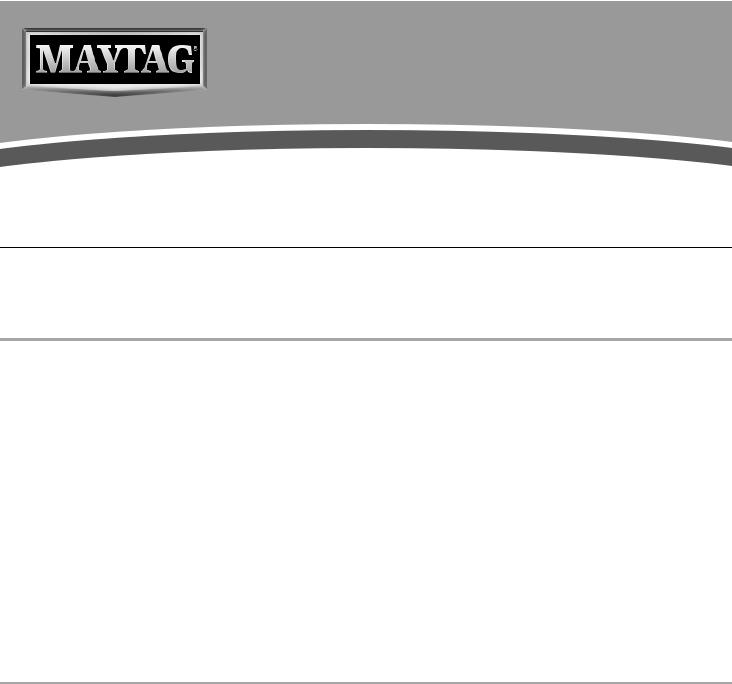
ELECTRIC RANGE
USER INSTRUCTIONS
THANK YOU for purchasing this high-quality product. If you should experience a problem not covered in TROUBLESHOOTING, please visit our website at www.maytag.ca for additional information. If you still need assistance, call us at 1-800-807-6777.
You will need your model and serial number located on the oven frame behind the top right side of the oven door.
Para obtener acceso a “Instrucciones para el usuario de la estufa eléctrica” en español, o para obtener información adicional acerca de su producto, visite: www.maytag.ca
Deberá tener a mano el número de modelo y de serie, que están ubicados en el marco del horno, detrás del lado derecho superior de la puerta del horno.
Table of Contents |
|
RANGE SAFETY....................................................................................... |
2 |
The Anti-Tip Bracket ............................................................................. |
2 |
FEATURE GUIDE ..................................................................................... |
4 |
COOKTOP USE........................................................................................ |
5 |
Cookware .............................................................................................. |
7 |
Home Canning ...................................................................................... |
8 |
OVEN USE ................................................................................................ |
8 |
Electronic Oven Controls ...................................................................... |
8 |
Sabbath Mode ...................................................................................... |
9 |
Aluminum Foil........................................................................................ |
9 |
Positioning Racks and Bakeware....................................................... |
10 |
Oven Vent............................................................................................ |
10 |
Baking and Roasting........................................................................... |
10 |
Broiling ................................................................................................ |
11 |
Convection Baking and Roasting ....................................................... |
11 |
Timed Cooking ................................................................................... |
11 |
RANGE CARE......................................................................................... |
12 |
Clean Cycle ......................................................................................... |
12 |
General Cleaning................................................................................. |
13 |
Oven Light ........................................................................................... |
14 |
TROUBLESHOOTING............................................................................ |
14 |
ACCESSORIES ...................................................................................... |
15 |
WARRANTY............................................................................................ |
16 |
W10667171A
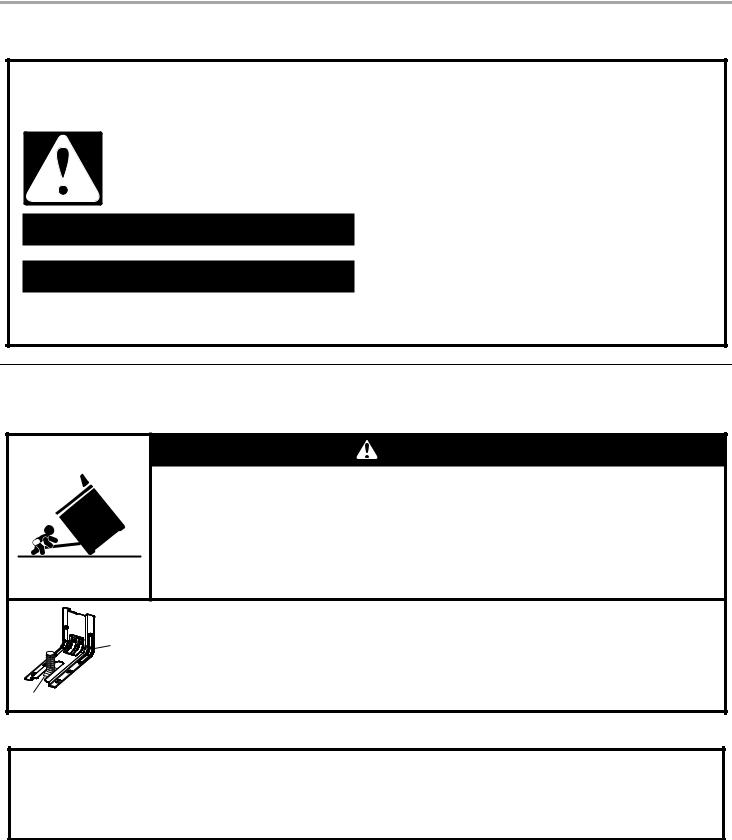
RANGE SAFETY
Your safety and the safety of others are very important.
We have provided many important safety messages in this manual and on your appliance. Always read and obey all safety messages.
This is the safety alert symbol.
This symbol alerts you to potential hazards that can kill or hurt you and others.
All safety messages will follow the safety alert symbol and either the word “DANGER” or “WARNING.” These words mean:
 DANGER
DANGER
 WARNING
WARNING
You can be killed or seriously injured if you don't immediately follow instructions.
You can be killed or seriously injured if you don't follow instructions.
All safety messages will tell you what the potential hazard is, tell you how to reduce the chance of injury, and tell you what can happen if the instructions are not followed.
The Anti-Tip Bracket
The range will not tip during normal use. However, the range can tip if you apply too much force or weight to the open door without having the anti-tip bracket fastened down properly.
|
WARNING |
|
Tip Over Hazard |
A child or adult can tip the range |
killed. |
Verify the anti-tip bracket has |
installed and engaged per installation instructions. |
Re-engage anti-tip bracket if range is moved.
Do not operate range without anti-tip bracket installed and engaged.
Failure to follow these instructions can result in death or serious burns to children and adults.
Anti-Tip
Bracket
Range Foot
To verify the anti-tip bracket is installed and engaged:
•Slide range forward.
•Look for the anti-tip bracket securely attached to floor or wall.
•Slide range back so rear range foot is under anti-tip bracket.
•See installation instructions for details.
State of California Proposition 65 Warnings:
WARNING: This product contains one or more chemicals known to the State of California to cause cancer.
WARNING: This product contains one or more chemicals known to the State of California to cause birth defects or other reproductive harm.
2

IMPORTANT SAFETY INSTRUCTIONS
WARNING: To reduce the risk of fire, electrical shock, injury to persons, or damage when using the range, follow basic precautions, including the following:
■ WARNING: TO REDUCE THE RISK OF TIPPING OF THE RANGE, THE RANGE MUST BE SECURED BY PROPERLY INSTALLED ANTI-TIP DEVICES. TO CHECK IF THE DEVICES ARE INSTALLED PROPERLY, SLIDE RANGE FORWARD, LOOK FOR ANTI-TIP BRACKET SECURELY ATTACHED TO FLOOR OR WALL, AND SLIDE RANGE BACK SO REAR RANGE FOOT IS UNDER ANTI-TIP BRACKET.
■ CAUTION: Do not store items of interest to children in cabinets above a range or on the backguard of a range – children climbing on the range to reach items could be seriously injured.
■Proper Installation – Be sure the range is properly installed and grounded by a qualified technician.
■Never Use the Range for Warming or Heating the Room.
■Do Not Leave Children Alone – Children should not be left alone or unattended in area where the range is in use. They should never be allowed to sit or stand on any part of the range.
■Wear Proper Apparel – Loose-fitting or hanging garments should never be worn while using the range.
■User Servicing – Do not repair or replace any part of the range unless specifically recommended in the manual. All other servicing should be referred to a qualified technician.
■Storage in or on the Range – Flammable materials should not be stored in an oven or near surface units.
■Do Not Use Water on Grease Fires – Smother fire or flame or use dry chemical or foam-type extinguisher.
■Use Only Dry Potholders – Moist or damp potholders on hot surfaces may result in burns from steam. Do not let potholder touch hot heating elements. Do not use a towel or other bulky cloth.
■DO NOT TOUCH SURFACE UNITS OR AREAS NEAR UNITS – Surface units may be hot even though they are dark in color. Areas near surface units may become hot enough to cause burns. During and after use, do not touch, or let clothing or other flammable materials contact surface units or areas near units until they have had sufficient time to cool. Among those areas are the cooktop and surfaces facing the cooktop.
■Use Proper Pan Size – The range is equipped with one or more surface units of different size. Select utensils having flat bottoms large enough to cover the surface unit heating element. The use of undersized utensils will expose a portion of the heating element to direct contact and may result in ignition of clothing. Proper relationship of utensil to burner will also improve efficiency.
■Never Leave Surface Units Unattended at High Heat Settings – Boilover causes smoking and greasy spillovers that may ignite.
■Make Sure Reflector Pans or Drip Bowls Are in Place – Absence of these pans or bowls during cooking may subject wiring or components underneath to damage.
■Protective Liners – Do not use aluminum foil to line surface unit drip bowls or oven bottoms, except as suggested in the manual. Improper installation of these liners may result in a risk of electric shock, or fire.
■Glazed Cooking Utensils – Only certain types of glass, glass/ceramic, ceramic, earthenware, or other glazed utensils are suitable for range-top service without breaking due to the sudden change in temperature.
■Utensil Handles Should Be Turned Inward and Not Extend Over Adjacent Surface Units – To reduce the risk of burns, ignition of flammable materials, and spillage due to unintentional contact with the utensil, the handle of a utensil should be positioned so that it is turned inward, and does not extend over adjacent surface units.
■Do Not Soak Removable Heating Elements – Heating elements should never be immersed in water.
■Do Not Cook on Broken Cooktop – If cooktop should break, cleaning solutions and spillovers may penetrate the broken cooktop and create a risk of electric shock. Contact a qualified technician immediately.
■Clean Cooktop With Caution – If a wet sponge or cloth is used to wipe spills on a hot cooking area, be careful to avoid steam burn. Some cleaners can produce noxious fumes if applied to a hot surface.
■Use Care When Opening Door – Let hot air or steam escape before removing or replacing food.
■Do Not Heat Unopened Food Containers – Build-up of pressure may cause container to burst and result in injury.
■Keep Oven Vent Ducts Unobstructed.
■Placement of Oven Racks – Always place oven racks in desired location while oven is cool. If rack must be moved while oven is hot, do not let potholder contact hot heating element in oven.
■DO NOT TOUCH HEATING ELEMENTS OR INTERIOR SURFACES OF OVEN – Heating elements may be hot even though they are dark in color. Interior surfaces of an oven become hot enough to cause burns. During and after use, do not touch, or let clothing or other flammable materials contact heating elements or interior surfaces of oven until they have had sufficient time to cool. Other surfaces of the appliance may become hot enough to cause burns – among these surfaces are oven vent openings and surfaces near these openings, oven doors, and windows of oven doors.
For self-cleaning ranges –
■Do Not Clean Door Gasket – The door gasket is essential for a good seal. Care should be taken not to rub, damage, or move the gasket.
■Do Not Use Oven Cleaners – No commercial oven cleaner or oven liner protective coating of any kind should be used in or around any part of the oven.
■Clean Only Parts Listed in Manual.
■Before Self-Cleaning the Oven – Remove broiler pan and other utensils.
For units with ventilating hood –
■Clean Ventilating Hoods Frequently – Grease should not be allowed to accumulate on hood or filter.
■When flambeing foods under the hood, turn the fan on.
SAVE THESE INSTRUCTIONS
3

FEATURE GUIDE
This manual covers several models. Your model may have some or all of the items listed. Refer to this manual or the Customer Service Section at www.maytag.ca.
|
|
|
|
|
|
|
|
|
WARNING |
|
|
|
|
|
|
|
|
|
|
Food Poisoning Hazard |
|
|
|
|
|
|
|
|
|
|
Do not let food sit in oven more than one hour before |
|
|
|
|
|
|
|
|
|
|
or after cooking. |
|
|
|
|
|
|
|
|
|
|||
|
|
|
|
|
|
|
|
|
Doing so can result in food poisoning or sickness. |
|
|
|
|
|
|
|
|
|
|||
|
|
|
|
|
||||||
|
|
|
|
|||||||
KEYPAD |
FEATURE |
INSTRUCTIONS |
|
|||||||
|
|
|
|
|||||||
CLOCK |
Clock |
The Clock uses a 12-hour cycle. |
|
|||||||
|
|
1. |
Check that the oven is off. |
|
||||||
|
|
2. |
Press CLOCK. |
|
||||||
|
|
3. |
Press TEMP/TIME “+” or “-” keypads to set the time of day. |
|
||||||
|
|
4. |
Press SET CLOCK or START. |
|
||||||
|
|
|
|
|||||||
LIGHT |
Oven cavity light |
The oven light is controlled by a keypad on the oven control panel. While the oven door is closed, |
|
|||||||
|
|
press the oven light switch to turn the light on and off. The oven light will come on when the oven |
|
|||||||
|
|
door is opened. |
|
|||||||
|
|
|
|
|||||||
KITCHEN |
Oven timer |
The Kitchen Timer can be set in hours or minutes up to 12 hours and 59 minutes. |
|
|||||||
TIMER |
|
1. |
Press KITCHEN TIMER. |
|
||||||
(on/off) |
|
|
||||||||
|
2. |
Press TEMP/TIME “+” or “-” keypads to set the length of time. |
|
|||||||
|
|
|
||||||||
|
|
3. |
Press START to begin the countdown. If enabled, end-of-cycle tones will sound at end of |
|
||||||
|
|
|
countdown. |
|
||||||
|
|
4. |
Press KITCHEN TIMER twice to cancel the Timer. Do not press the Cancel keypad because the |
|
||||||
|
|
|
oven will turn off. |
|
||||||
|
|
5. |
If the Kitchen Timer is running, but not in the display, press KITCHEN TIMER to display the |
|
||||||
|
|
|
countdown for 5 seconds. |
|
||||||
|
|
|
|
|||||||
START |
Cooking start |
The Start pad begins any oven function. If Start is not pressed within 2 minutes, “PUSH” appears |
|
|||||||
|
|
in the display. If Start is not pressed within 1 minute after pressing a keypad, the function is |
|
|||||||
|
|
canceled and the time of day is displayed. |
|
|||||||
|
|
|
|
|||||||
CANCEL |
Range function |
The Cancel keypad stops any function except the Clock, Kitchen Timer and Oven Control Lockout. |
|
|||||||
|
|
|
|
|||||||
TEMP/TIME |
Temperature and |
The “+” or “-” keypads are used to adjust time and temperature settings. |
|
|||||||
|
time adjust |
|
|
|
|
|
|
|
|
|
|
|
|
|
|
||||||
BAKE |
Baking and |
1. |
Press BAKE. |
|
||||||
|
roasting |
2. |
Press TEMP/TIME “+” or “-” keypads to set a temperature other than 350°F (175°C) in 5° |
|
||||||
|
|
|
increments between 170°F and 500°F (75°C and 260°C). |
|
||||||
|
|
3. |
Press START. |
|
||||||
|
|
4. |
To change the temperature, repeat Step 2. Press START for the change to take effect. |
|
||||||
|
|
5. |
Press CANCEL when finished. |
|
||||||
|
|
|
|
|
||||||
BROIL |
Broiling |
1. |
Press BROIL. |
|
||||||
|
|
2. |
Press TEMP/TIME “+” or “-” keypads to change the temperature in 5° increments between |
|
||||||
|
|
|
300°F and 500°F (150°C and 260°C). |
|
||||||
|
|
3. |
Press START, and allow oven to preheat for 5 minutes. |
|
||||||
|
|
4. |
Position cookware in the oven and close the oven door to the broil stop position so that the |
|
||||||
|
|
|
door is open approximately 6" (15 cm). |
|
||||||
|
|
5. |
Press CANCEL when finished. |
|
||||||
|
|
|
|
|
|
|
|
|
|
|
CONVECT Convection BAKE baking and
roasting
1.Press CONVECT BAKE.
2.Press TEMP/TIME “+” or “-” keypads to set a temperature other than 350°F (175°C) in 5° increments between 170°F and 500°F (75°C and 260°C).
3.Press START.
4.To change the temperature, repeat Step 2. Press START for the change to take effect.
5.Press CANCEL when finished.
4
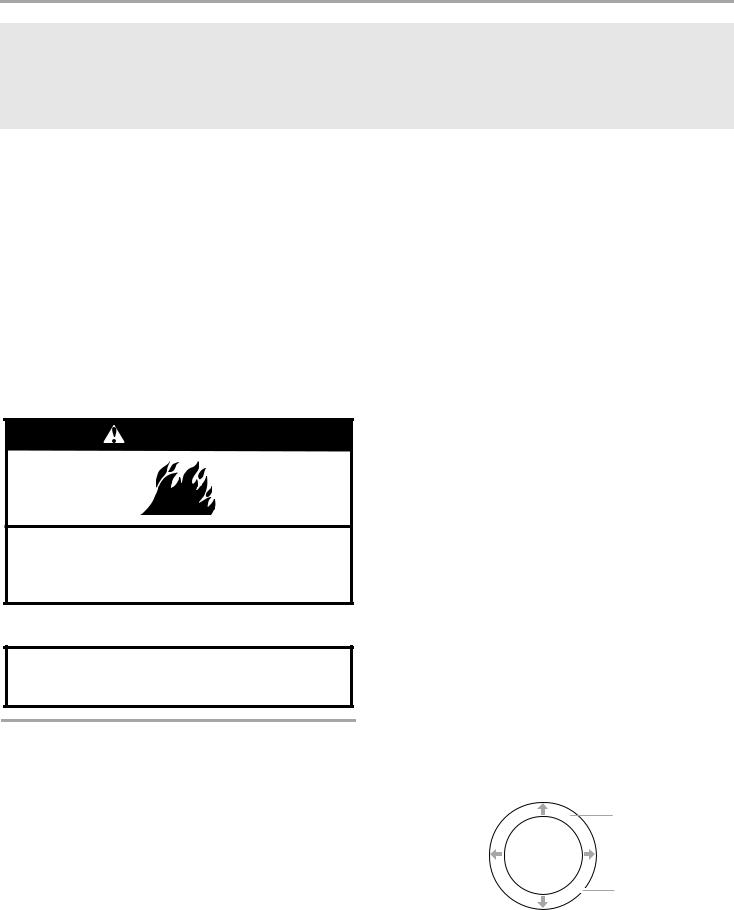
KEYPAD |
FEATURE |
INSTRUCTIONS |
|
KEEP WARM |
Hold warm |
Food must be at serving temperature before placing it in the warmed oven. |
|
|
|
1. |
Press KEEP WARM. |
|
|
2. |
Temperature is set at 170°F (75°C) for 60 minutes (1 hour). |
|
|
3. |
Press START. |
|
|
4. |
Press CANCEL when finished. |
NOTE: The oven will automatically turn off after 60 minutes.
DELAY START |
Delayed start |
The Delay Start keypad is used to enter the starting time for an oven function with a delayed start. |
|
|
|
Delay start should not be used for foods such as breads and cakes because they may not bake |
|
|
|
properly. |
|
|
|
To set a Timed Cook or a Delayed Timed Cook, see “Timed Cooking” section. |
|
|
|
|
|
COOK TIME |
Timed cooking |
Timed Cooking allows the oven to be set to turn on at a certain time of day, cook for a set length of |
|
|
|
time, and/or shut off automatically. |
|
|
|
To set a Timed Cook or a Delayed Timed Cook, see “Timed Cooking” section. |
|
|
|
|
|
AQUALIFT |
Clean cycle |
See the “Clean Cycle” section. |
|
SELF CLEAN |
|
|
|
|
|
|
|
START |
Oven control |
1. |
Check that the oven is off. |
(hold 3 sec |
lockout |
2. |
Press and hold the START (hold 3 sec to lock) keypad for 3 seconds. |
to lock) |
|
||
|
3. |
A tone will sound, and “Loc” will be displayed. |
|
|
|
||
|
|
4. |
Repeat to unlock. Only the Clock, Kitchen Timer and Oven Light keypads will function with the |
|
|
|
controls locked. The cooktop functions are not affected by the oven control lockout. |
|
|
|
|
|
|
|
|
COOKTOP USE
WARNING
Fire Hazard
Turn off all controls when done cooking.
Failure to do so can result in death or fire.
The control knobs can be set to anywhere between HIGH and LOW. Push in and turn to setting.
REMEMBER: When range is in use or (on some models) during the Self-Cleaning cycle, the entire cooktop area may become hot.
Ceramic Glass
The surface cooking area will glow red when an element is on. Some parts of the surface cooking area may not glow red when an element is on. This is normal operation. It may cycle on and off to maintain the selected heat level.
It is normal for the surface of light colored ceramic glass to appear to change color when surface cooking areas are hot. As the glass cools, it will return to its original color.
Clean the cooktop after each use to help avoid scratches, pitting, abrasions and to condition the glass surface. Ceramic glass cooktop cleaner and a cooktop scraper are also recommended for stubborn soils. Do not use abrasive cleaners, cleaning pads or harsh chemicals for cleaning. The Cooktop Care Kit Part Number 31605 contains all of the items needed to clean and condition your ceramic glass cooktop. Refer to the “Range Care” section for additional information.
IMPORTANT: To avoid permanent damage to the cooktop surface and to make soils easier to remove, clean the cooktop after each use to remove all soils.
■Avoid storing jars or cans above the cooktop. Dropping a heavy or hard object onto the cooktop could crack the cooktop.
■To avoid damage to the cooktop, do not leave a hot lid on the cooktop. As the cooktop cools, air can become trapped between the lid and the cooktop, and the ceramic glass could break when the lid is removed.
■For foods containing sugar in any form, clean up all spills and soils as soon as possible. Allow the cooktop to cool down slightly. Then, while wearing oven mitts, remove the spills using a scraper while the surface is still warm. If sugary spills are allowed to cool down, they can adhere to the cooktop and can cause pitting and permanent marks.
■To avoid scratches, do not slide cookware or bakeware across the cooktop. Aluminum or copper bottoms and rough finishes on cookware or bakeware could leave scratches or permanent marks on the cooktop.
■Do not cook popcorn in prepackaged aluminum containers on the cooktop. They could leave aluminum marks that cannot be removed completely.
■To avoid damage to the cooktop, do not allow objects that could melt, such as plastic or aluminum foil, to touch any part of the entire cooktop.
■To avoid damage to the cooktop, do not use the cooktop as a cutting board.
■Use cookware about the same size as the surface cooking area. Cookware should not extend more than ½" (1.3 cm) outside the area.
B
A
C
A.Surface cooking area
B.Cookware/canner
C.½" (1.3 cm) maximum overhang
5
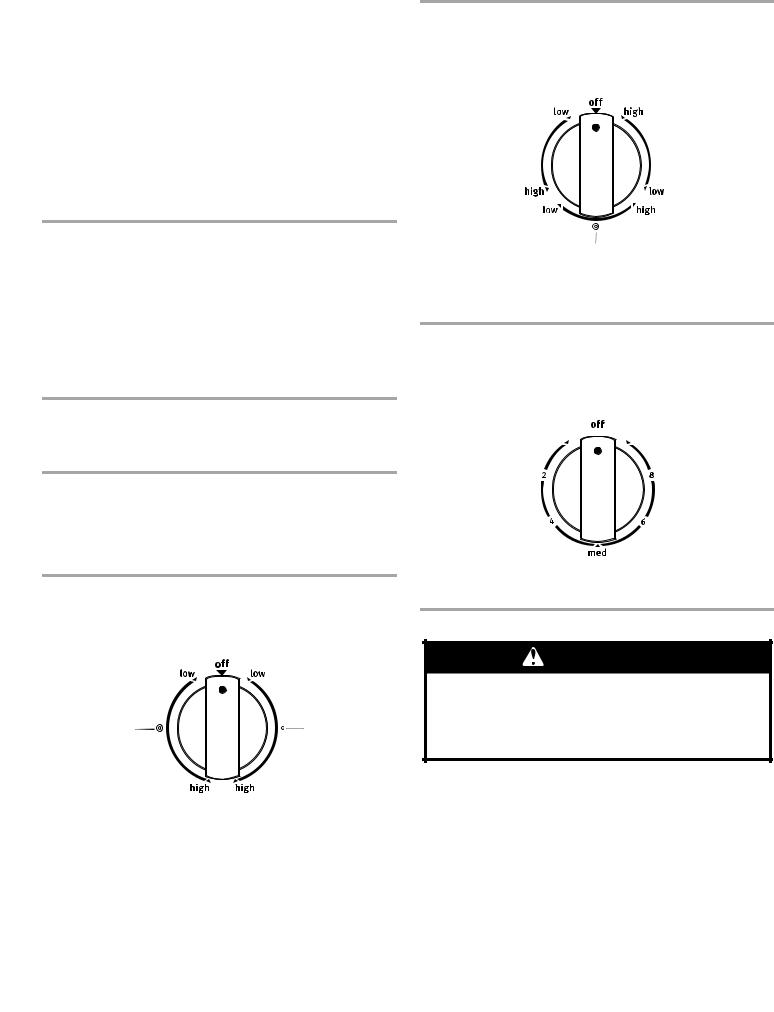
■Use flat-bottomed cookware for best heat conduction and energy efficiency. Cookware with rounded, warped, ribbed or dented bottoms could cause uneven heating and poor cooking results.
■Determine flatness by placing the straight edge of a ruler across the bottom of the cookware. While you rotate the ruler, no space or light should be visible between it and the cookware.
■Cookware designed with slightly indented bottoms or small expansion channels can be used.
■Make sure the bottoms of pots and pans are clean and dry before using them. Residue and water can leave deposits when heated.
■To avoid damage to the cooktop, do not cook foods directly on the cooktop.
Ceramic Glass Cooktop Cleaning
Clean the cooktop after each use to help avoid scratches, pitting, abrasions and to condition the glass surface. Ceramic glass cooktop cleaner and a cooktop scraper are also recommended for stubborn soils. Do not use abrasive cleaners, cleaning pads or harsh chemicals for cleaning. The Cooktop Care Kit Part Number 31605 contains all of the items needed to clean and condition your ceramic glass cooktop. Refer to the “Range Care” section for additional information.
IMPORTANT: To avoid permanent damage to the cooktop surface and to make soils easier to remove, clean the cooktop after each use to remove all soils.
Cooktop On Indicator Light
The Cooktop On indicator light is located on the console panel. When any control knob on the console panel is turned on, the Cooktop On indicator light will glow.
Hot Surface Indicator Light (on some models)
On ceramic glass models, the hot surface indicator light is located on the console panel.
The hot surface indicator light will glow as long as any surface cooking area is too hot to touch, even after the surface cooking area is turned off.
Dual Choice™ Cooking Element (on some models)
The Dual Choice™ Cooking Element offers flexibility depending on the size of the cookware. Single size can be used in the same way as a regular element. The dual size combines both the single and outer element and is recommended for larger size cookware.
A |
B |
A.Dual
B.Single
Triple-Choice Cooking Element (on some models)
The Triple-Choice Cooking Element offers flexibility depending on the size of the cookware. Single size can be used in the same way as a regular element. The dual and triple sizes combine single, dual and outer elements and are recommended for larger size cookware, large quantities of food, and home canning.
A 


 C
C
B
A.Single
B.Dual
C.Triple
Power™ Element Cooking Zone (on some models)
The Power™ Element Cooking Zone offers flexibility for 2 optional heating choices. The High heat option can be used to boil liquids faster. The Melt option can be used to prepare sauces, to brown or saute foods and to keep food at a low temperature. Use cookware appropriate in size for the Power™ Element Cooking Zone.
A 




 B
B
A.Melt option
B.High heat option
Warming Center Element
WARNING
Food Poisoning Hazard
Do not let food sit for more than one hour before or after cooking.
Doing so can result in food poisoning or sickness.
Use the Warming Center element to keep cooked foods warm. One hour is the recommended maximum time to maintain food quality.
Do not use it to heat cold foods.
The Warming Center element can be used alone or when any of the other surface cooking areas are being used.
The Warming Center element area will not glow red when cycling on. However, the Element On light will glow while the Cooktop Warming Center element is in use.
6
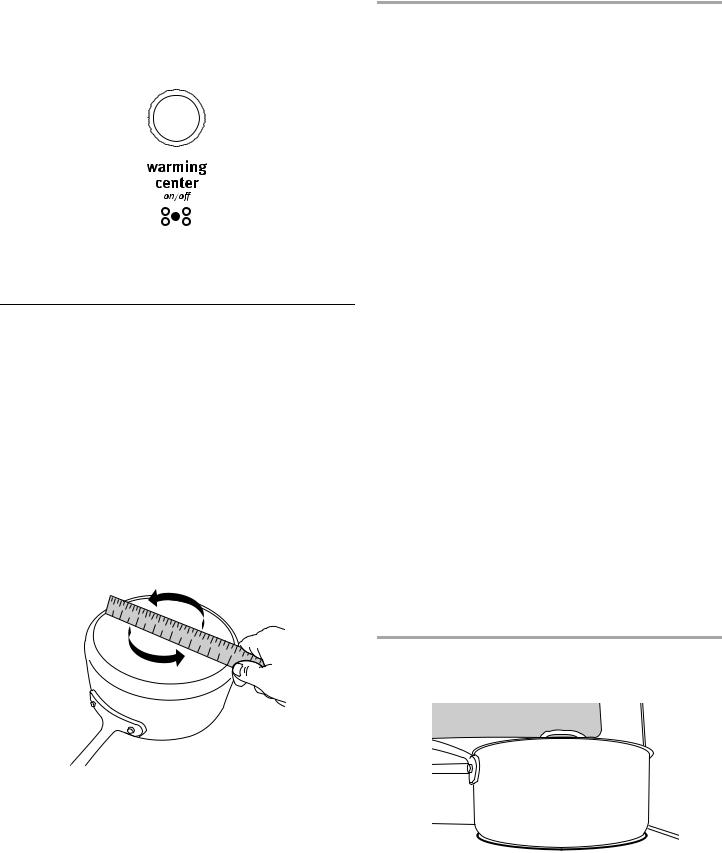
■Use only cookware recommended for oven and cooktop use.
■Cover all foods with a lid or aluminum foil. When warming baked goods, allow a small opening in the cover for moisture to escape.
■To avoid damage to the cooktop, do not use plastic wrap to cover food because the plastic wrap may melt.
■Use pot holders or oven mitts to remove food.
To Use:
1.To turn on, press WARMING CENTER push button.
2.To turn off, press WARMING CENTER push button a second time.
Cookware
IMPORTANT: Do not leave empty cookware on a hot surface cooking area, element or surface burner.
Ideal cookware should have a flat bottom, straight sides and a wellfitting lid, and the material should be of medium-to-heavy thickness.
Rough finishes may scratch the cooktop. Aluminum and copper may be used as a core or base in cookware. However, when used as a base they can leave permanent marks on the surfaces.
Cookware material is a factor in how quickly and evenly heat is transferred, which affects cooking results. A nonstick finish has the same characteristics as its base material. For example, aluminum cookware with a nonstick finish will take on the properties of aluminum.
Cookware with nonstick surfaces should not be used under the broiler.
Check for flatness by placing the straight edge of a ruler across the bottom of the cookware. While you rotate the ruler, no space or light should be visible between it and the cookware.
1 |
|
2 |
|
|
3 |
1 |
4 |
5 |
|
|
6 |
|
2 |
1 2 |
1 3 |
|
|
|
|
|
|
5 |
1 |
4 |
|
|
|
||
|
|
1 5 |
|
|
|
1 |
6 |
|
|
6 |
1 7 |
|
1 8 |
|
7 |
1 |
9 |
|
|
2 0 |
Use the following chart as a guide for cookware material characteristics.
COOKWARE |
CHARACTERISTICS |
||
|
|
|
|
Aluminum |
■ |
Heats quickly and evenly. |
|
|
■ Suitable for all types of cooking. |
||
|
■ Medium or heavy thickness is best for |
||
|
|
most cooking tasks. |
|
|
■ May leave aluminum residues, which |
||
|
|
may be diminished if cleaned |
|
|
|
immediately after cooking. |
|
|
|
|
|
Cast iron |
■ |
Heats slowly and evenly. |
|
|
■ Good for browning and frying. |
||
|
■ Maintains heat for slow cooking. |
||
|
■ Rough edges or burrs may scratch the |
||
|
|
cooktop. |
|
|
|
|
|
Ceramic or |
■ |
Follow manufacturer’s instructions. |
|
Ceramic glass |
■ |
Heats slowly, but unevenly. |
|
|
|||
|
■ Ideal results on low to medium heat |
||
|
|
settings. |
|
|
■ May scratch the cooktop. |
||
|
|
|
|
Copper |
■ |
Heats very quickly and evenly. |
|
|
■ May leave copper residues, which |
||
|
|
may be diminished if cleaned |
|
|
|
immediately after cooking |
|
|
■ Can leave a permanent stain or bond |
||
|
|
to the cooktop if overheated. |
|
|
|
|
|
Earthenware |
■ |
Follow manufacturer’s instructions. |
|
|
■ Use on low heat settings. |
||
|
■ May scratch the cooktop. |
||
|
|
|
|
Porcelain |
■ |
See stainless steel or cast iron. |
|
enamel-on- |
■ |
Porcelain enamel bakeware without |
|
steel or cast |
|||
|
the metal base may bond to the |
||
iron |
|
||
|
cooktop if overheated. |
||
|
|
||
|
|
|
|
Stainless steel |
■ |
Heats quickly, but unevenly. |
|
|
■ A core or base of aluminum or copper |
||
on stainless steel provides even heating.
Use flat-bottomed cookware for best cooking results and energy efficiency. The cookware should be about the same size as the cooking area outlined on the cooktop. Cookware should not extend more than ½" (1.3 cm) outside the area.
7

Home Canning
Canning can be performed on a glass smooth top cooking surface or traditional coil element cooktop. When canning for long periods, alternate the use of surface cooking areas or elements between batches. This allows time for the most recently used areas to cool.
■Center the canner on the largest surface cooking area or element. On electric cooktops, canners should not extend more than ½" (1.3 cm) beyond the surface cooking area or element.
■Do not place canner on 2 surface cooking areas or elements at the same time.
■On ceramic glass models, use only flat-bottomed canners to avoid damage to the cooktop and elements.
■For more information, contact your local agricultural extension office, or refer to published home canning guides. Companies that manufacture home canning products can also offer assistance.
OVEN USE
Odors and smoke are normal when the oven is used the first few times, or when it is heavily soiled.
IMPORTANT: The health of some birds is extremely sensitive to the fumes given off. Exposure to the fumes may result in death to certain birds. Always move birds to another closed and wellventilated room.
Electronic Oven Controls
Control Display
The display will flash when powered up or after a power loss. Press CANCEL to clear. When oven is not in use, the time of day is displayed, unless the range is in Energy Save mode. During Energy Save mode, the display will be blank. Indicator lights show functions that are in use.
Tones
Tones are audible signals, indicating the following:
Basic Functions
One tone
■Valid pad press
■Oven is preheated (long tone)
■Function has been entered
■Reminder (on some models), repeating every 20 seconds after the end-of-cycle tones
Three tones
■Invalid pad press
Four tones
■End of cycle
Energy Save
The Energy Save feature places the control and clock into a Sleep mode that reduces power consumption when the range is not being used.
To enter the Energy Save mode, the oven and control must be idle with the time of day shown on the display. Press and hold CLOCK for 10 seconds. The control will beep, and the display will show the letters “ES” followed by “On” twice. The display will return to the time of day.
If Energy Save mode is activated, each time the range is idle for 5 minutes with only the time of day shown, the display will show the letters “ES” followed by “On” twice. The display will then be
blank until a control key is pressed or the oven door is opened. The control will then perform any of its operations in response to additional key presses.
To exit Energy Save mode, press and hold the CLOCK key for 10 seconds. The control will beep, and the display will show the letters “ES” followed by “Off” twice. The display will return to the time of day.
Oven Temperature Control
IMPORTANT: Do not use a thermometer to measure oven temperature because opening the oven door may cause element cycling to give incorrect readings.
The oven provides accurate temperatures; however, it may cook faster or slower than your previous oven, so the temperature can be adjusted to personalize it for your cooking needs. It can be changed in Fahrenheit or Celsius.
To Adjust Oven Temperature:
1.Press and hold BAKE for 5 seconds until the oven display shows the current setting, for example “0°F CAL” or “00.”
2.Press the Temp/Time “+” or “-” keypads to increase or to decrease the temperature in 10°F (5°C or 6°C) amounts. The adjustment can be set between 30°F (17°C) and -30°F (-17°C).
3.Press START.
Options Mode
Press and hold KITCHEN TIMER for 5 seconds, and “Opt” will appear. Use the Temp/Time “+” or “-” keypads to cycle through the following options. Press CANCEL to exit the mode.
Fahrenheit and Celsius
The temperature is preset at Fahrenheit, but can be changed to Celsius. Press KITCHEN TIMER to toggle between Fahrenheit and Celsius. Press CANCEL to exit.
End of Cycle Tones
“b1” (beep once) or “b” (continue to beep) will be displayed. Press KITCHEN TIMER to toggle through selections. Press CANCEL to exit.
Oven Light with Door Open
“LOn” indicates that the oven light will turn on when the door is open. If “LOFF” is displayed, the oven light will turn on only with the oven light switch. Press KITCHEN TIMER to toggle through selection. Press CANCEL to exit.
12-Hour Shutoff
If “12 Hr” is displayed, the oven will automatically shut off after 12 hours. Press KITCHEN TIMER to toggle to “- Hr” to disable the 12-hour shutoff. Press CANCEL to exit.
8

Sabbath Mode
The Sabbath Mode sets the oven to remain on in a Bake setting until turned off. A Timed Bake can also be set to keep the oven on for only part of the Sabbath. The Oven Control Lockout Feature (if present) will be disabled during the Sabbath Mode. After the Sabbath Mode is set no tones will sound, the display will not show the temperature, the Kitchen Timer Mode will be canceled (if active) and only the following pads will function:
■“+” or “-” keypads
■Cancel
When the oven door is opened or closed, the oven light will not turn on or off and the heating elements will not turn on or off immediately.
To set a Timed Bake using Sabbath Mode (on some models):
WARNING
Food Poisoning Hazard
Do not let food sit in oven more than one hour before or after cooking.
Doing so can result in food poisoning or sickness.
When power is restored after a power failure, the oven will return to Sabbath Mode and remain Sabbath compliant with the bake elements off until the Cancel keypad is pressed.
Pressing the Cancel keypad at any time returns the oven to the normal cooking mode (not Sabbath Mode compliant).
Before entering the Sabbath Mode, it must be decided if the oven light is to be on or off for the entire Sabbath Mode period. If the light is on when entering Sabbath Mode, it will remain on for the entire time Sabbath Mode is in use. If the light is off when entering Sabbath Mode, it will remain off for the entire time Sabbath Mode is in use. Opening the oven door or pressing the Oven Light keypad will not affect the oven light once Sabbath Mode has been entered.
If the oven has the Convection Bake feature, the oven light is controlled by a separate Oven Light switch on the console. If the oven light is on when entering the Sabbath Mode, it will remain on for the entire time Sabbath Mode is in use. For the oven light to be off during the Sabbath Mode, the light bulb must be removed from the oven prior to entering the Sabbath Mode. Not performing these steps will cause the oven light to turn on when the oven door is opened, resulting in the oven being not Sabbath compliant.
On the Holiday, the oven temperature can be changed once the oven is in Sabbath Mode by pressing the “+” or “-” keypads. The oven temperature will change 25°F (14°C) each time the keypad is pressed. The display will not change, and there will be no sounds during this adjustment.
To Bake Using Sabbath Mode:
1.Press BAKE.
2.Press the “+” or “-” keypads.
3.Press START.
4.Press and hold the TIMER keypad for 5 seconds. “SAb” will flash in the display.
5.Press START within 5 seconds to enter Sabbath Mode; otherwise, the entire cycle cancels out. “SAb” will stop flashing and remain on in the display. The oven is now in Sabbath Mode and is Sabbath compliant.
Pressing the Cancel keypad at any time returns the oven to the normal cooking mode (not Sabbath Mode compliant).
1.Press BAKE.
2.Press the “+” or “-” keypads to enter a temperature other than the one displayed.
3.Press COOK TIME. The Cook Time oven indicator light will light up.
4.Press the “+” or “-” keypads to enter a cook time length.
5.Press START.
6.Press and hold the TIMER keypad for 5 seconds. “SAb” will flash in the display.
7.Press START within 5 seconds to enter Sabbath Mode; otherwise, the entire cycle cancels out. “SAb” will stop flashing and remain on in the display. The oven is now in Sabbath Mode and is Sabbath compliant. The Bake, On and Cook Time indicator lights will be displayed.
When the set cook time ends, the oven will shut off automatically and the indicator lights will turn off, indicating the end of the cycle.
Pressing the Cancel keypad at any time returns the oven to the normal cooking mode (not Sabbath Mode compliant).
To set a Delayed Timed Bake using Sabbath Mode (on some models):
1.Press BAKE.
2.Press the “+” or “-” keypads to enter a temperature other than the one displayed.
3.Press COOK TIME. The Cook Time oven indicator light will light up.
4.Press the “+” or “-” keypads to enter a cook time length.
5.Press START TIME or DELAY START. The Start Time/Delay Start indicator light will light up.
6.Press the “+” or “-” keypads to enter a start time.
7.Press START.
8.Press and hold the TIMER keypad for 5 seconds. “SAb” will flash in the display.
9.Press START within 5 seconds to enter Sabbath Mode; otherwise, the entire cycle cancels out. “SAb” will stop flashing and remain on in the display. The oven is now in Sabbath Mode and is Sabbath compliant. The On and Delay indicator lights will be displayed.
When the start time is reached the Bake, On and Cook Time indicator lights will automatically turn on. When the set cook time ends, the oven will shut off automatically and the indicator lights will turn off, indicating the end of the cycle.
Pressing the Cancel keypad at any time returns the oven to the normal cooking mode (not Sabbath Mode compliant).
Aluminum Foil
IMPORTANT: To avoid permanent damage to the oven bottom finish, do not line the oven bottom with any type of foil or liner.
For best cooking results, do not cover entire oven rack with foil because air must be able to move freely.
9
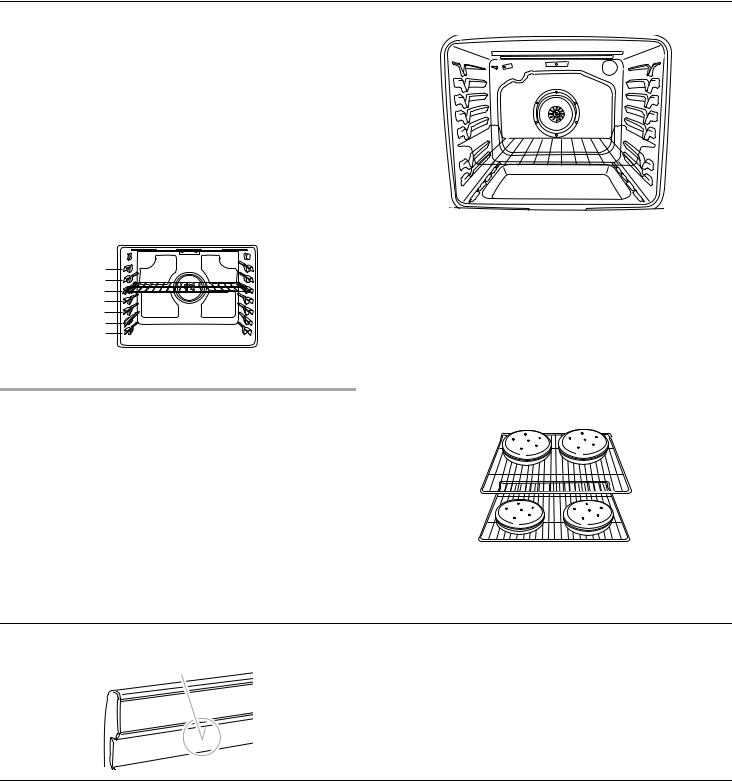
Positioning Racks and Bakeware
IMPORTANT: To avoid permanent damage to the porcelain finish, do not place food or bakeware directly on the oven door or bottom.
Bakeware
To cook food evenly, hot air must be able to circulate. Allow 2" (5 cm) of space around bakeware and oven walls. Make sure that no bakeware piece is directly over another.
Racks
■Position racks before turning on the oven.
■Do not move racks with bakeware on them.
■Make sure racks are level.
To move a rack, pull it out to the stop position, raise the front edge, and then lift out. Use the following illustration and charts as a guide.
7
6
5
4
3
2
1
The oven has 7 positions for a flat rack, as shown in the previous illustration and the following table.
Flat Rack Position* |
Type of Food |
7 |
Broiling/searing meats, hamburgers, |
|
steaks |
6 |
Broiled meats, poultry, fish |
3 or 4 |
Most baked goods, casseroles |
2 |
Roasted meats |
1 |
Large roasts or poultry |
|
|
For hamburger patties to have a well-seared exterior and a rare interior, use rack position 7. Side 1 should cook for approximately 2½ - 3½ minutes. Side 2 should cook for approximately
4-5 minutes. Expect a moderate degree of smoke when broiling.
*If your model has a Max Capacity Oven Rack, the recessed ends must be placed in the rack position above the desired position of the food. See the following illustration.
A 



 B
B
A.Ends of rack in position 3
B.Food in position 2
IMPORTANT: These rack positions are for flat racks. If a Max Capacity Oven Rack is used, the rack position must be adjusted as shown in the previous figure.
Multiple Rack Cooking
2-rack (non-convection): Use rack positions 2 and 5. 2-rack (convection): Use rack positions 2 and 5.
Baking Cookies and Layer Cakes on 2 Racks
Baking Layer Cakes
For best results when baking cakes on 2 racks, use the Bake function and racks 2 and 5. Place the cakes on the racks as shown.
Baking Cookies
For best results when baking cookies on 2 racks, use the Bake function and rack positions 2 and 5.
Oven Vent
A. Oven vent
A
The oven vent releases hot air and moisture from the oven, and should not be blocked or covered. Blocking or covering the oven vent will cause poor air circulation, affecting cooking and cleaning results. Do not set plastics, paper or other items that could melt or burn near the oven vent.
Baking and Roasting
Precision Cooking™ System - Precise Bake
The Precise Bake system electronically regulates the oven heat levels during preheat and bake to maintain a precise temperature range for optimal cooking results. The bake and broil elements cycle on and off in intervals. The bake element will glow red when cycling on; the broil element will not. This feature is automatically activated when the oven is in use.
Before baking and roasting, position racks according to “Positioning Racks and Bakeware” section. When roasting, it is not necessary to wait for the oven preheat cycle to end before putting food in unless it is recommended in the recipe.
Preheating
When Start is pressed, the oven will begin preheating. Once 100ºF (38ºC) is reached, the display temperature will increase as the actual temperature of the oven increases. When the preheat temperature is reached, a tone will sound, and the selected temperature will appear on the display.
The time to preheat the oven to 350°F (175°C) will be approximately 10-15 minutes depending upon the model.
10
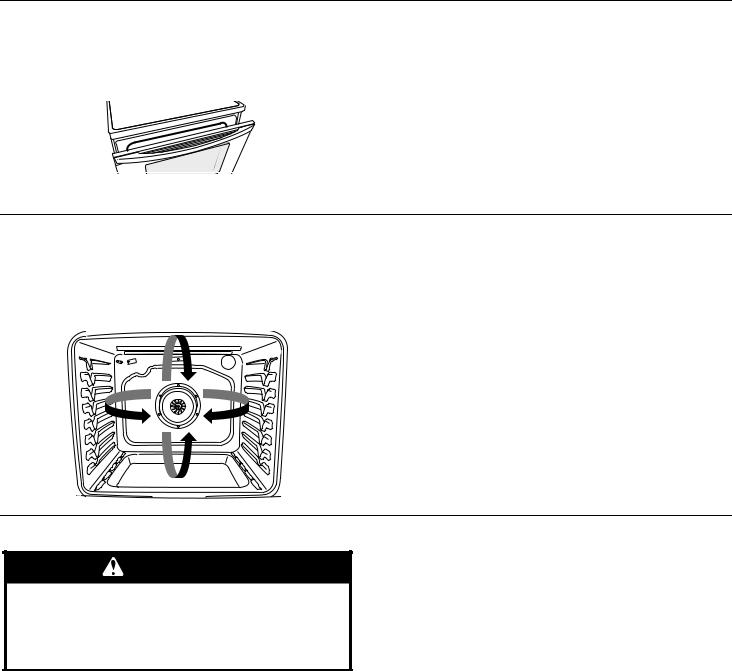
Broiling
Leave the door open 6" (15 cm) at the broil stop position to ensure proper broiling temperature. Preheat the oven for 5 minutes before putting food in unless recommended otherwise in the recipe.
Position food on grid in a broiler pan, then place it in the center of the oven rack.
NOTE: Odors and smoke are normal the first few times the oven is used or if the oven is heavily soiled.
Changing the temperature when broiling allows more precise control when cooking. The lower the broil setting, the slower the cooking. Thicker cuts and unevenly shaped pieces of meat, fish and poultry may cook better at lower broil settings. Use racks 6 or 7 for broiling. Refer to the “Positioning Racks and Bakeware” section for more information.
On lower settings, the broil element will cycle on and off to maintain the proper temperature.
■For best results, use a broiler pan and grid. It is designed to drain juices and help avoid spatter and smoke.
If you would like to purchase a broiler pan, one may be ordered. Please refer to the “Accessories” section for more information.
Convection Baking and Roasting (on some models)
In a convection oven, the fan-circulated hot air continually distributes heat more evenly than the natural movement of air in a standard thermal oven. This movement of hot air helps maintain a consistent temperature throughout the oven, cooking foods more evenly, crisping surfaces while sealing in moisture and yielding crustier breads.
With convection cooking, most foods can be cooked at a temperature 25°F (15°C) lower than in a standard thermal oven, and cooking time can be shortened by up to 30%.
During convection baking or roasting, the bake and broil elements cycle on and off in intervals to maintain the oven temperature, while the fan circulates the hot air.
If the oven door is opened during convection baking or roasting, the fan will turn off immediately. It will come back on when the oven door is closed.
Timed Cooking (on some models)
WARNING
Food Poisoning Hazard
Do not let food sit in oven more than one hour before or after cooking.
Doing so can result in food poisoning or sickness.
To Set a Timed Cook:
1.Press BAKE. The bake indicator light will light up.
2.Press the TEMP/TIME “+” or “-” keypads to enter a temperature other than the one displayed.
3.Press COOK TIME. The cook time oven indicator light will light up.
4.Press the TEMP/TIME “+” or “-” keypads to enter the length of time to cook.
5.Press START. The display will count down the time. When the time ends, the oven will shut off automatically and “End” will appear on the display.
6.Press CANCEL to clear the display.
To Set a Delayed Timed Cook:
Before setting, make sure the clock is set to the correct time of day. See the “Clock” keypad feature in the “Feature Guide” section.
1.Press BAKE.
2.Press the TEMP/TIME “+” or “-” keypads to enter a temperature other than the one displayed.
3.Press COOK TIME. The cook time oven indicator light will light up.
4.Press TEMP/TIME “+” or “-” keypads to enter the length of time to cook.
5.Press DELAY START. The delay oven indicator light will light up.
6.Press TEMP/TIME “+” or “-” keypads to enter the time of day to start.
7.Press START.
When the start time is reached, the oven will automatically turn on. The temperature and/or time settings can be changed anytime after pressing Start by repeating steps 1-7. When the set cook time ends, the oven will shut off automatically and “End” will appear on the display.
8.Press CANCEL to clear the display.
11
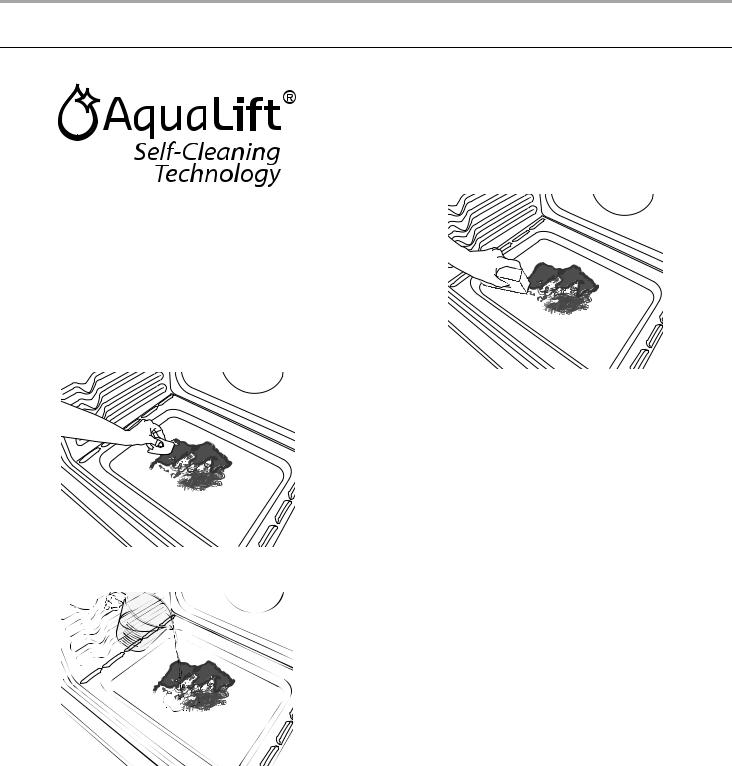
RANGE CARE
Clean Cycle
AquaLift® Technology is an innovative cleaning solution that utilizes heat and water to release baked-on spills from the oven in less than 1 hour. This new cleaning technology is a low-heat, odor-free alternative to traditional self-cleaning options.
Allow the oven to cool to room temperature before using the Clean cycle. If your oven cavity is above 200°F (93°C), “HOT” will appear in the display, and the Clean cycle will not be activated until the oven cavity cools down.
To Clean:
1.Remove all racks and accessories from the oven cavity and wipe excess soil. Use a plastic scraper to remove easilyremoved soils.
2.Pour 2 cups (16 oz [500 mL]) of distilled or filtered water onto the bottom of the empty oven and close the oven door.
IMPORTANT: Do not use chemicals or other additives with the water. Do not open the oven door during the Clean cycle. The water on the oven bottom is hot.
3.Press AQUALIFT SELF CLEAN and then START on the oven control panel.
4.Allow 40 minutes for cleaning and cool down. A beep will sound when the Clean cycle is complete.
5.Press CANCEL at the end of the cycle. CANCEL may be pressed at any time to stop the Clean cycle.
6.Remove the residual water and loosened soils with a sponge or cloth immediately after the Clean cycle is complete. Much of the initial 2 cups (16 oz [500 mL]) of water will remain in the oven after the cycle is completed. If additional soils remain, leave a small amount of water in the oven bottom to assist with the cleaning.
7.If any soils remain, remove them with a non-scratch scrubbing sponge or plastic scraper. Additional Clean cycles may be run to help remove the stubborn soils.
IMPORTANT: Do not use oven cleaners. The use of chemicals, including commercial oven cleaners or metal scouring pads, may cause permanent damage to the porcelain surface of the oven interior.
NOTES:
■The range should be level to ensure that the entire surface of the bottom of the oven cavity is covered by water at the beginning of the Clean cycle.
■For best results, use distilled or filtered water. Tap water may leave mineral deposits on the oven bottom.
■Before removing the residual water and loosened soils at the end of the Clean cycle, insert a cloth or paper towel between the lower edge of the oven door and the front frame to keep water from spilling onto the front of the range and the floor.
■Soil baked on through several cooking cycles will be more difficult to remove with the Clean cycle.
■Nonabrasive scrub sponges or eraser style cleaning pads (without cleaners) can be effective for cleaning the oven cavity walls, oven door and oven bottom for difficult soils. For best results, moisten the pads and sponges before use.
■Run an additional Clean cycle for stubborn soils.
■affresh® Kitchen Appliance Cleaner and affresh® Cooktop Cleaner may be used to clean the oven bottom, walls and door when the oven has finished the cycle and returned to room temperature. If affresh® Cooktop Cleaner is used, it is recommended to wipe out the cavity with distilled water as well. Refer to the “Accessories” section for information on ordering.
■Additional AquaLift® Technology Cleaning Kits may be obtained by ordering Part Number W10423113RP. See the “Accessories” section for more information.
■For assistance with AquaLift® Technology, call 1-877-258-0808, or visit our website at http://whr.pl/aqualift.
12
